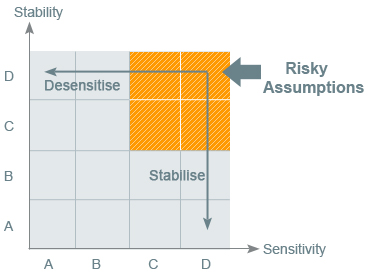Why traditional risk management fails and how ABCD fixes this?
Assumption Based Communication Dynamics (ABCD) was developed in the 1990s to address the problems with traditional risk management approaches.
Today the core processes of ABCD Risk Management have been developed and used under the SDA umbrella. Yet many of our clients are familiar with the original ABCD methodology which has been used in many organisations, across many industries and across many geographies. The simple way of looking at this is that SDA is a subset of ABCD but contains all the elements that we find are essential for clients in the world today.

What is wrong with traditional methods?
The traditional approaches to risk management are based on identifying risks, perhaps through some form of workshop, adding impact and probability ratings, either qualitatively or quantitatively, and then multiplying these together to come up with a risk exposure which allows prioritisation and action.
It all sounds good in theory but in practice, there are likely to be significant problems with this approach.
100% certainty and perfect levels of communication do not exist, but the intrinsic characteristics of traditional risk management can make communication more difficult and therefore increase risk.
Effective communication is vital in any management process. Within programme teams there will be a number of individuals with different viewpoints. Therefore, a fundamental objective of any risk management process should be to get everyone “on the same page” and to expose any differences of opinion. Traditional risk management does not tend to encourage dialogue: as a result, different viewpoints are not shared, and people are unable or reluctant to bring their own knowledge to the table. This is due to the psychology of perceived and actual negativity that surrounds risk management language.
Projects are all about achieving objectives by set timescales, i.e. positive ventures. Yet risk is a negative entity so to get people to think and talk openly about their risks can be a challenge.
For example, when you ask a project manager, “what are your risks?”, this can have two primary effects:
- The project manager’s brain is thinking positively and is suddenly asked a question that is pushing in completely the opposite direction. The effect is to “confuse” the brain so that it starts thinking about things that might go wrong but are not linked to the objectives of the project. The effect can be to generate spurious risks which are not linked to the project objectives, e.g. a plane might crash on the building!
- The project manager immediately starts to think things like “what are you going to do with this information?” and may feel threatened that their fears may be shared with colleagues and superiors making them feel vulnerable. The effect will be that they share the risks they are comfortable about managing and not the ones that are their real concerns.
This psychological barrier can significantly compromise risk identification and therefore will undermine the whole risk management process.
How ABCD fixes this
ABCD is De-RISK’s proprietary methodology that enables the capture of differing knowledge and viewpoints from stakeholders, in a form that facilitates communication of issues, assumptions and ensures management of risks. By dramatically improving communication, risks are avoided or managed proactively, and objectives are delivered on time and to budget.
ABCD works where other risk management approaches fail. One of the main reasons for this is that ABCD focuses on positives (ie assumptions) rather than negatives (ie risks) and is therefore seen as a positive exercise by people who would normally feel uncomfortable with a “risk assessment”.
ABCD is fully scaleable – it can be used on everything from small projects to large scale programmes and full business enterprises. Most importantly, ABCD is a true enterprise risk management approach in that it can handle all the hierarchies and escalation profiles that traditional methods normally fail to address and therefore ensures that management can “see the wood from the trees”.
The key features and benefits of ABCD are:
- Communication – Provides a simple, common, language for the communication of risk up, down and sideways within the organization, whilst avoiding the normal problems of political sensitivity and dislike of discussing risks.
- Control – Enhances project control by an exception management approach and provides a simple overview of complex risks for senior management to prompt decision making
- Flexibility – An adaptable process which, once tailored to the organisation, is rigorously applied to ensure that all significant risks to the projects are identified and controlled at the appropriate time.
- Acceptable – The non-intrusive/non-bureaucratic management process improves management discipline across the organization and is readily accepted by project teams
